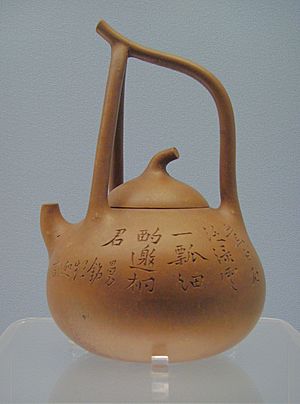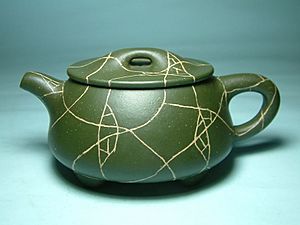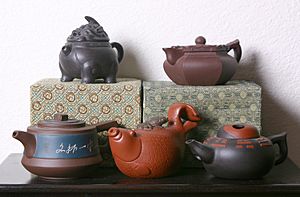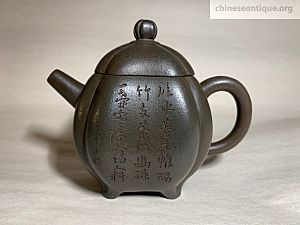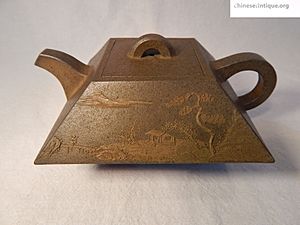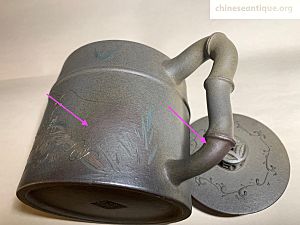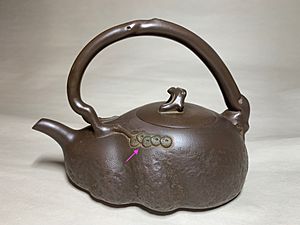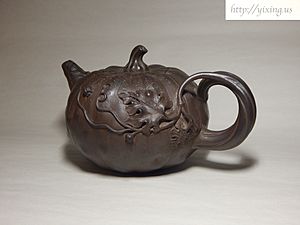Yixing clay teapot facts for kids
Yixing clay teapots are special teapots from China. People also call them Zisha teapots. This name means "Purple Clay" teapots. They are made from a unique type of clay found near the city of Yixing. This city is in the eastern Chinese province of Jiangsu.
These traditional teapots have been used to brew tea for a very long time. Their history goes all the way back to the 15th century.
Contents
History of Yixing Teapots
Scientists have found old pottery near Yixing from the Song Dynasty (about 10th century). These early potters used a local clay called "zisha," which means "purple sand" or "purple clay." They made bowls and other items that might have been used for tea.
Later, in the Ming dynasty, a writer named Zhou Gaoqi wrote about a monk. This monk lived at Jinsha Temple in Yixing. He made a very good teapot from the local clay. Soon, smart and educated people, called the scholarly class, loved these teapots. This is how Yixing teapots became famous.
Yixing Teapots in the 20th Century
Even though they are called Yixing teapots, many are actually made in a nearby town. This town is called Dīngshān, or Dingshu. It is located on the west side of Lake Tai. Today, Dīngshān is a popular place for tourists. Many teapot shops line the streets there.
Dīngshān has many ceramics factories. One of the biggest is Yíxīng Zǐshā Factory Number 1. It opened in 1958. This factory processes a lot of the clay used in the area. They also make beautiful pottery and have a large shop. Besides teapots, they make other items too. These include tea pets, jars for oil and grain, flower vases, figurines, and even decorative rocks.
How to Use Yixing Teapots
Yixing teapots are best for certain types of tea. These include puer, black, and oolong teas. You can use them for green or white teas too. But, Yixing teapots hold heat very well. This makes brewing green or white tea a bit tricky. For these teas, the water should not be hotter than 85 degrees Celsius (185°F).
A special thing about Yixing teapots is how they work. With each use, they soak up tiny bits of tea flavor and minerals. Over time, these build up inside the pot. This creates a special coating that makes future teas taste even better. Because of this, you should never use soap to clean a Yixing teapot. Just rinse it with fresh water and let it air dry.
Many tea lovers use only one type of tea in a specific Yixing teapot. This helps the pot develop the best flavor for that tea. If you brew many different types of tea in one pot, the flavors can mix. This might make your tea taste muddy.
Some Yixing teapots are smaller than teapots you might see in Western countries. This is because tea is often brewed using the gongfu style. This style uses less water and shorter brewing times. The tea is then poured into small teacups, usually holding about 30 ml (about 1 ounce) or less. This lets you drink the tea quickly before it gets cold.
Price of Yixing Teapots
The price of Yixing teapots can be very different. They can cost from a few dozen to thousands of yuan (Chinese money). In 2010, one teapot was sold for 12.32 million yuan at an auction!
The price of a Yixing teapot depends on many things. These include how old it is, the type of clay used, and who made it. The style and how it was made also matter. The most expensive teapots are shaped by hand. Makers use wooden and bamboo tools to form the clay. Cheaper Yixing pots are often made using a method called slipcasting.
Types of Clay for Yixing Teapots
The kind of clay used greatly changes how a teapot looks and feels. There are three main colors of Zisha clays: Purple, Red, and Beige.
- Purple Clay: This is the most common type.
- Red Clay: Another popular choice.
- Beige Clay: This often comes from a mix of different clays called Duan ni.
A special type of purple clay is called Tianqing clay. In the past, this clay was very rare and sought after. People thought it was all used up. However, this is not true. In the Ming dynasty, it was hard to dig up purple clay because it was deep underground (about 30 meters). With new technology, it's much easier to get purple clay now, including Tianqing clay.
Tianqing clay is special because:
- It turns a dark liver color after it's fired.
- It feels much sandier.
- It lets water pass through more easily. This helps it form a unique, slightly clear shine over time.
- It can turn greenish after being used for a while. It can even look like jade! This is different from green colors that appear during firing.
For example, the teapot called 風卷葵壺 was made by Yang FengNian in the Qing dynasty. It was made from Tianqing clay. This teapot is now kept at the Yixing Ceramic Museum.
Examples of Zisha Teapots Made with Purple Clay
| Picture | Name | Main colors | Feel and look very sandy, extreme permeability | Shiny or metallic | Odd coloration |
|---|---|---|---|---|---|
| Yixing teapot with Shao Hengyu mark | Blue or dark grey, or greenish (after usage or soaked in water for a week) | Yes | Yes | No | |
| Yixing teapot with Yang Pengnian mark | Dark liver | Yes | Yes | No | |
| Yixing teapot with Shi Jichang mark | Green, with multiple purple areas | Yes | Yes | Yes | |
| Yixing teapot with Qingquan Meiyu mark | Dark liver, green for thin areas (after soaked in water for a week) | Not obviously | Yes for green areas | Dark liver color and green color at the same time | |
| Yixing teapot with Chen Mingyuan mark | Dark liver, plus Blue or Dark Grey, and Green particles | Yes | Yes | Dark liver, blue or dark grey, and green particles at the same time |
See also
 In Spanish: Tetera de Yixing para niños
In Spanish: Tetera de Yixing para niños


